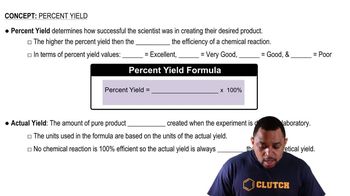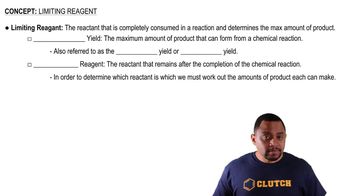Magnesium oxide can be made by heating magnesium metal in the presence of oxygen. The balanced equation for the reaction is: 2 Mg(s) + O2(g) → 2 MgO(s) When 10.1 g of Mg reacts with 10.5 g O2, 11.9 g MgO is collected. Determine the limiting reactant, theoretical yield, and percent yield for the reaction.
Ch.4 - Chemical Quantities & Aqueous Reactions
Chapter 4, Problem 52c
Many computer chips are manufactured from silicon, which occurs in nature as SiO2. When SiO2 is heated to melting, it reacts with solid carbon to form liquid silicon and carbon monoxide gas. In an industrial preparation of silicon, 155.8 kg of SiO2 reacts with 78.3 kg of carbon to produce 66.1 kg of silicon. Determine the percent yield for the reaction.
 Verified step by step guidance
Verified step by step guidance1
insert step 1> Write the balanced chemical equation for the reaction: SiO_2 (s) + 2C (s) -> Si (l) + 2CO (g).
insert step 2> Calculate the molar masses of SiO_2, C, and Si using the periodic table.
insert step 3> Convert the given masses of SiO_2 and C to moles using their respective molar masses.
insert step 4> Determine the theoretical yield of silicon by using stoichiometry based on the limiting reactant.
insert step 5> Calculate the percent yield using the formula: (actual yield / theoretical yield) * 100.

Verified video answer for a similar problem:
This video solution was recommended by our tutors as helpful for the problem above.
Video duration:
2mWas this helpful?
Key Concepts
Here are the essential concepts you must grasp in order to answer the question correctly.
Stoichiometry
Stoichiometry is the calculation of reactants and products in chemical reactions based on the balanced chemical equation. It allows chemists to determine the proportions of substances involved in a reaction, which is essential for predicting how much product can be formed from given amounts of reactants.
Recommended video:
Guided course

Stoichiometry Concept
Percent Yield
Percent yield is a measure of the efficiency of a chemical reaction, calculated by comparing the actual yield of a product to the theoretical yield. It is expressed as a percentage and provides insight into how much of the expected product was actually obtained, helping to assess the effectiveness of the reaction conditions.
Recommended video:
Guided course

Percent Yield in Reactions
Limiting Reactant
The limiting reactant is the substance that is completely consumed first in a chemical reaction, thus determining the maximum amount of product that can be formed. Identifying the limiting reactant is crucial for accurate stoichiometric calculations and for determining the theoretical yield of the reaction.
Recommended video:
Guided course

Limiting Reagent Concept
Related Practice
Textbook Question
1
views
Textbook Question
Urea (CH4N2O) is a common fertilizer that is synthesized by the reaction of ammonia (NH3) with carbon dioxide: 2 NH3(aq) + CO2(aq) → CH4N2O(aq) + H2O(l) In an industrial synthesis of urea, a chemist combines 136.4 kg of ammonia with 211.4 kg of carbon dioxide and obtains 168.4 kg of urea. Determine the limiting reactant, theoretical yield of urea, and percent yield for the reaction.
Textbook Question
Calculate the molarity of each solution.
a. 3.25 mol of LiCl in 2.78 L solution
b. 28.33 g C6H12O6 in 1.28 L of solution
Textbook Question
Calculate the molarity of each solution.
c. 32.4 mg NaCl in 122.4 mL of solution
1
views
Textbook Question
Calculate the molarity of each solution. a. 0.38 mol of LiNO3 in 6.14 L of solution b. 72.8 g C2H6O in 2.34 L of solution c. 12.87 mg KI in 112.4 mL of solution
